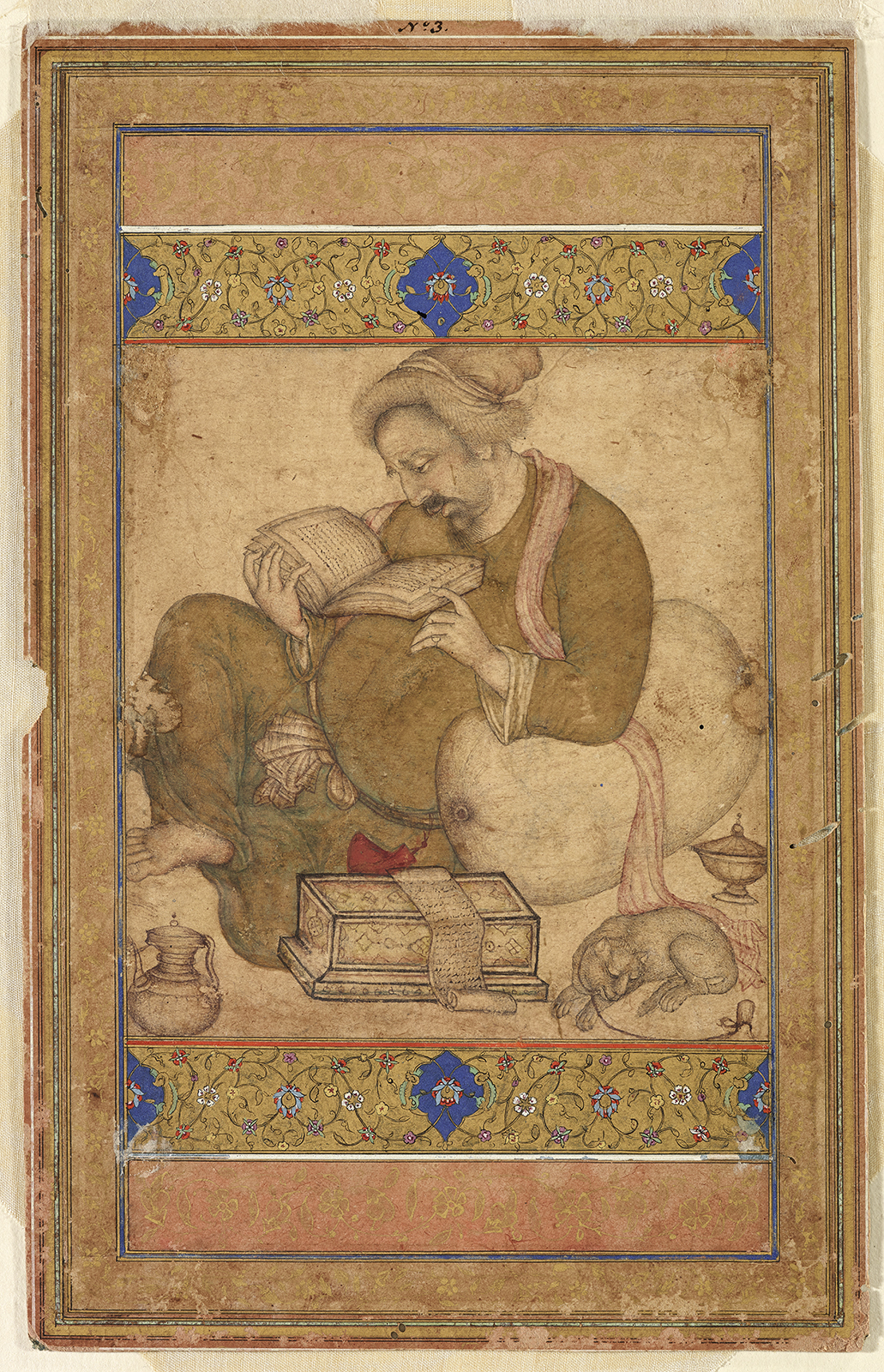Click on the image to zoom
Learned Man
- Accession Number:AKM906
- Creator:attributed to Basawan
- Place:India
- Dimensions:23.1 x 15.2 cm
- Date:1575–80
- Materials and Technique:ink and opaque watercolour on paper
The subject of this single-page drawing has been most often described as a learned man, but he also possesses qualities that may indicate he is a dignified Sufi. However, he wears rings on both little fingers, which might not reflect the modesty of a Sufi. This drawing was attached to a folio for an album assembled in 1611–12 for Prince Khurram. Nineteen years old at the time, the prince would later be known as Shah Jahan. The reverse bears a panel of calligraphy in the hand of the prince dated 1605. The illuminated borders at the top and bottom seem contemporary with the drawing.[1] This Indian drawing of an Iranian topic is attributed to Basawan (1556–1600) by Stuart Cary Welch, and is executed in the nim qalam (half-pen) technique, a specialty of Basawan at the Mughal court.[2]
Further Reading
Nim qalam is a method of creating drawings as finished works, a kind of tinted drawing especially developed in the Mughal Empire and the favoured technique of the Iranian artist Aqa Reza [3] (1560–1621) (see AKM166). The technique is closely related to European grisaille, a method of painting or drawing in grey monochrome that was often used to imitate sculpture and engravings, especially those of Flemish and German origin. Basawan knew of Western works of art in grisaille and was interested in the European knowledge of volume and perspective that he saw in them. They may have been a source when Basawan created his extremely fine brush drawings in black ink. He transformed European subjects through nim qalam into something new and different, creating a perfect hybrid.
As a young Hindu, Basawan joined the courtly workshop of Akbar at Delhi.[4] He was probably trained by Abd al-Samad, a great artist and an émigré from Tabriz who was involved in and laid the foundation of the Mughal school of painting.[5] Basawan became one of the great masters of the courtly Mughal workshop for more than 40 years.[6] It seems that corpulent people were a hallmark of Basawan’s art. A later drawing of an inebriated European shows similar attributes to the learned man in this drawing.[7]
— Filiz Çakır Phillip
Notes
[1] Stuart Cary Welch, Indian Drawings and Painted Sketches, 16th Through 19th Centuries (New York: Asia House Gallery, 1976), 35.
[2] Amina Okada, “Basawan,” in Master Artists of the Imperial Mughal Court, ed. Pratapaditya Pal (Mumbai: Marg Publications, 1991), 11.
[3] Majlis Library, Tehran, Acc. No. 13651, 38r.
[4] John Guy and Jorrit Britschgi, Wonder of the Age: Master Painters of India 1100–1900 (New York: The Metropolitan Museum of Art, 2011), 42.
[5] Welch, Indian Drawings and Painted Sketches, 34.
[6] Okada, 2.
References
Guy, John, and Jorrit Britschgi. Wonder of the Age: Master Painters of India 1100–1900. New York: The Metropolitan Museum of Art, 2011. ISBN: 9781588394309
Okada, Amina. “Basawan.” In Master Artists of the Imperial Mughal Court, ed. Pratapaditya Pal. Mumbai: Marg Publications, 1991, 1–16. ISBN: 978-8185026152
Phillip, Filiz Çakır. Enchanted lines: drawings from the Aga Khan Museum collection. 2014. ISBN: 9780991992874
Sarre, Friedrich, and Eugen Mittwoch. Zeichnungen von Riza Abbasi. Munich: F. Bruckmann, 1914.
Welch, Stuart Cary. Indian Drawings and Painted Sketches, 16th Through 19th Centuries. New York: Asia House Gallery, 1976. ISBN: 9780878480463
Note: This online resource is reviewed and updated on an ongoing basis. We are committed to improving this information and will revise and update knowledge about this object as it becomes available.


